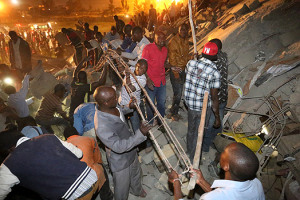
The Huruma Collapse: Nairobi News: http://nairobinews.co.ke/two-dead-scores-trapped-in-huruma-collapsed-building/ January 5, 2015.
In light of the recent incidents of collapsing buildings in the city, most recently in Huruma, the Nairobi County Assembly has been recalled from recess on Tuesday the 20th January 2015 to fast track the passing of a new bill that city hall hopes will help address the lack of development control in the city. The Bill aims to set up a committee to regularize Nairobi’s “unauthorized buildings” which will also help to ensure that they are in compliance with safety and other standards.NPI readers are encouraged to look at The Nairobi City County Regularization of Developments Bill 2014 and submit any comments to the Office of the Nairobi County Assembly Clerk via email to [email protected] and tweets to @NrbCityAssembly.
While this is a good step forward, it raises the question of whether the Physical Planning Act 1997 needs reviewing, what kind of building codes and safety standards exist and whether they need modification- a discussion that has been ongoing for many years without clear progress on the policy end. This is of particular concern to some middle and low income communities in Nairobi which still legally must adhere to the very cumbersome and expensive processes detailed in the Physical Planning Act along with unrealistic building codes. These communities and households have minimal resources for “regularization fees” and redesign in order to be in line with the law as it exists.
An investigation into why development control fails is also critical at this point so the County needs a more holistic and comprehensive approach to the problem. The Architectural Association of Kenya has for some years being attempting to draw attention to the poor development control frameworks in the country and published a report prior to devolution in 2011 called ‘A Study in Development Control Frameworks in Kenya”. It merits a reread as it reveals the myriad of problems in how local government (now counties) have (mis) managed development control.
One of the major concerns of those in charge of development control at the local level is political interference. There is also the question of inadequate budget for control, technical competence, low public awareness, slow processing and corruption which clearly undermines implementation of any proper control.These are institutional problems that need serious public and policy deliberation and action. The County should consult with the Architectural Association of Kenya, other professionals, and residents associations to more fully address these issues. Overall, then, while the aims of the bill make sense, it will not address the broader legal, capacity and governance issues at play. One might also worry about whether the bill just might give a great deal of power and ability to an executive committee to extract “fees” without a lot of public accountability. Empowering tenants and other concerned citizens to report safety concerns would be a step forward. It would be important to see some open information and data clauses in the bill (in line with the much neglected Article 35 of the Constitution of Kenya) to ensure the public can scrutinize and access all decisions and trace the fees which presumably would go back into a reform process including the hiring of more technical support to address the serious development control issues in the city.
NPI encourages its readers to review the bill and comment to the county! Send emails to [email protected] and tweets to @NrbCityAssembly.
